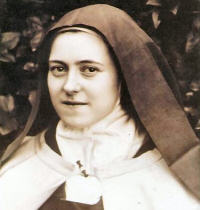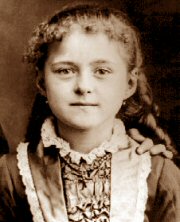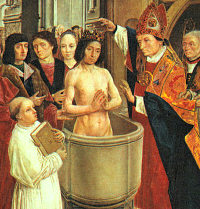
Daily Readings for:October 01, 2014
(Readings on USCCB website)
Collect: O God, who open your Kingdom to those who are humble and to little ones, lead us to follow trustingly in the little way of Saint Thérèse , so that through her intercession we may see your eternal glory revealed. Through our Lord Jesus Christ, your Son, who lives and reigns with you in the unity of the Holy Spirit, one God, for ever and ever.
RECIPES
ACTIVITIES
o Nameday Ceremony for St. Therese of the Child Jesus
o St. Thérèse — Stubborn Saint
o Therese of Lisieux — Stubborn Saint
o To Make Rose Beads for a Rosary
PRAYERS
o Novena to St. Theresa of the Child Jesus (Rose Novena)
o Litany of Saint Therese of the Child Jesus, "The Little Flower"
o Table Blessing for the Feast of St. Therese of the Child Jesus
LIBRARY
o Homily at Mass Proclaiming St. Therese of Lisieux a Doctor of the Church | Pope John Paul II
o Saint Theresa of Lisieux | Pope Benedict XVI
o Saint Thérèse of Lisieux | Unknown
o Short Biography of St. Therese of Lisieux | Unknown
o St. Thérèse’s Teacher: Our Lady of the Little Way | Fr. John Saward
o Teresa of Lisieux -- No Plaster Saint | Hilda Graef
· Ordinary Time: October 1st
· Memorial St. Therese of the Child Jesus, virgin and Doctor of the Church
Old Calendar: St. Remigius, bishop, confessor (Remi) ; Other Titles: The Little Flower; Theresa of the Child Jesus; Teresa of the Child Jesus; Thérèse of the Child Jesus and the Holy Face; Therese of the Infant Jesus; Thérèse Lisieux; Theresa Lisieux; Therese Lisieux
Today is the memorial of St. Thérèse of the Child Jesus and the Holy Face, more popularly known as "the Little Flower." Although just an obscure cloistered Carmelite nun, she has had universal appeal since her death in 1897. St. Thérèse is the patroness of all foreign missions and patroness of France. Her feast day was formerly October 3.
According to the 1962 Missal of St. John XXIII the Extraordinary Form of the Roman Rite, today is the feast of St. Remigius, bishop and confessor, who died in 533. He baptized King Clovis, bringing the Frankish nation to Christianity. He is one of the patrons of France.
St. Thérèse Marie Thérèse Martin was born at Alençon, France on January 2, 1873, the youngest of five daughters. Her father, Louis, was a watchmaker, and her mother, Zelie, who died of breast cancer when Thérèse was four, was a lace maker. She was brought up in a model Christian home. While still a child she felt the attraction of the cloister, and at fifteen obtained permission to enter the Carmel of Lisieux. For the next nine years she lived a very ordinary religious life. There are no miracles, exploits or austerities recorded of her. She attained a very high degree of holiness by carrying out her ordinary daily duties with perfect fidelity, having a childlike confidence in God's providence and merciful love and being ready to be at the service of others at all times. She also had a great love of the Church and a zeal for the conversion of souls. She prayed especially for priests. She died of consumption on September 30, 1897, at the age of 24, and was canonized in 1925. She has never ceased to fulfill her promise: "I will pass my heaven in doing good on earth." Her interior life is known through her autobiography called Story of a Soul. Pope John Paul II declared her a Doctor of the Church in 1997.
Marie Thérèse Martin was born at Alençon, France on January 2, 1873, the youngest of five daughters. Her father, Louis, was a watchmaker, and her mother, Zelie, who died of breast cancer when Thérèse was four, was a lace maker. She was brought up in a model Christian home. While still a child she felt the attraction of the cloister, and at fifteen obtained permission to enter the Carmel of Lisieux. For the next nine years she lived a very ordinary religious life. There are no miracles, exploits or austerities recorded of her. She attained a very high degree of holiness by carrying out her ordinary daily duties with perfect fidelity, having a childlike confidence in God's providence and merciful love and being ready to be at the service of others at all times. She also had a great love of the Church and a zeal for the conversion of souls. She prayed especially for priests. She died of consumption on September 30, 1897, at the age of 24, and was canonized in 1925. She has never ceased to fulfill her promise: "I will pass my heaven in doing good on earth." Her interior life is known through her autobiography called Story of a Soul. Pope John Paul II declared her a Doctor of the Church in 1997.
Patron: florists; foreign missions; missionaries; pilots; against tuberculosis; AIDS sufferers; illness; loss of parents; Australia; France; Russia; Diocese of Fairbanks, Alaska; Diocese of Fresno, California; Diocese of Juneau, Alaska; Diocese of Pueblo, Colorado.
Symbols: roses; discalced Carmelite nun holding roses; Carmelite nun with roses at her feet; Carmelite nun holding images of the Child Jesus and Holy Face of Jesus; Carmelite nun holding a crucifix and roses; book.
Things to Do:
- Find photographs of St. Thérèse and her family.
Her sister Céline and cousin Marier Guérin had become interested in the art of photography, and when Céline entered the Carmelites with her sisters, she was given permission to bring her equipment and use it in the convent. A wonderful out-of-print book with all the photographs of this saint is called The Photo Album of St. Thérèse of Lisieux. - Read St. Thérèse's autobiography Story of a Soul and other writings of or about St. Thérèse. Find biographies suitable for your children.
- Read more about her confidence in God, an excellent book is I Believe in Love.
- St. Thérèse belonged to the Discalced order of Carmelites, which means unshod or barefoot. Find out more about the order of Carmelites.
- From the Catholic Culture Library:
- John Paul II from 1997 Divini Amoris Scientia (Apostolic Letter Proclaiming St. Therese of Lisieux a Doctor of the Church)
- John Paul II from 1997 Homily at Mass proclaiming Therese to be Doctor of the Church
- Apostolic Exhortation of Paul VI from 1975 On Christian Joy (Gaudete in Domino). He speaks of St. Therese:
In more recent times, St. Therese of Lisieux shows us the courageous way of abandonment into the hands of God to whom she entrusts her littleness. And yet it is not that she has no experience of the feeling of God's absence, a feeling which our century is harshly experiencing: "Sometimes it seems that the little bird (to which she compared herself) cannot believe that anything else exists except the clouds that envelop it.... This is the moment of perfect joy for the poor, weak little thing.... What happiness for it to remain there nevertheless, and to gaze at the invisible light that hides from its faith."
- Learn about the Society of the Little Flower.
- There is the historic National Shrine of the Little Flower in Royal Oak, Michigan, a Basilica of the National Shrine of the Little Flower in San Antonio, Texas.
- Bake a cake or brownies and frost. Decorate with roses, either real, artificial, marzipan, icing, candy or other. Let your imagination go! See top bar for marzipan suggestions.
- Learn about St. Therese's sacrifice beads, buy or learn to make them.
- Do some rose crafts or recipes today. St. Therese's dying words were: "I will let fall a shower of roses after my death." This site has some wonderful old-fashioned rose recipes.
St. Remigius Also known as Remi, he was born at Laon, the son of Count Emilius of Laon and St. Celina. He became known for his preaching, and in 459, when he was only twenty-two, he was appointed bishop of Rheims. He was ordained and consecrated and reigned for more than seventy years, devoting himself to the evangelization of the Franks. In 496, Clovis, pagan King of northern Gaul, supposedly in response to a suggestion by his wife, Clotildis, a Christian, invoked the Christian God when the invading Alemanni were on the verge of defeating his forces, whereupon the tide of battle turned and Clovis was victorious. St. Remigius, aided by St. Vedast, instructed him and his chieftains in Christianity, and soon after baptized Clovis, his two sisters, and three thousand of his followers. Remigius was a zealous proponent of orthodoxy, opposed Arianism, and converted an Arian bishop at a synod of Arian bishops in 517. He was censured by a group of bishops for ordaining one Claudius, whom they felt was unworthy of the priesthood, but St. Remigius was generally held in great veneration for his holiness, learning, and miracles. He was the most influential prelate of Gaul and is considered the apostle of the Franks. He died at Rheims on January 13. — Dictionary of Saints, John J. Delaney
Also known as Remi, he was born at Laon, the son of Count Emilius of Laon and St. Celina. He became known for his preaching, and in 459, when he was only twenty-two, he was appointed bishop of Rheims. He was ordained and consecrated and reigned for more than seventy years, devoting himself to the evangelization of the Franks. In 496, Clovis, pagan King of northern Gaul, supposedly in response to a suggestion by his wife, Clotildis, a Christian, invoked the Christian God when the invading Alemanni were on the verge of defeating his forces, whereupon the tide of battle turned and Clovis was victorious. St. Remigius, aided by St. Vedast, instructed him and his chieftains in Christianity, and soon after baptized Clovis, his two sisters, and three thousand of his followers. Remigius was a zealous proponent of orthodoxy, opposed Arianism, and converted an Arian bishop at a synod of Arian bishops in 517. He was censured by a group of bishops for ordaining one Claudius, whom they felt was unworthy of the priesthood, but St. Remigius was generally held in great veneration for his holiness, learning, and miracles. He was the most influential prelate of Gaul and is considered the apostle of the Franks. He died at Rheims on January 13. — Dictionary of Saints, John J. Delaney
Patron: France.
Symbols: Oil stock; dove with Holy Ampulla in its beak; birds; veil of St. Veronica; font; broken fetters.
Often Portrayed As: Dressed as a bishop with a miter and staff with a cross and is holding the oil of the sacred phial in his right hand with a dove hovering over. For centuries the events at the crowning of Clovis I became a symbol used by the monarchy to claim the divine right to rule.
Things to Do: Things to Do:
- Learn about Rheims, France and the Cathedral of Our Lady of Rheims where King Clovis was baptized.
- Find out what the divine right of kings means.
- Offer reparation by prayers and good works for the losses resulting from the infidelity of France (the eldest daughter of the Church) as well as much of Europe, who has departed from the faith on which their culture was built.
- Read Pope John Paul's Apostolic Exhortation, Ecclesia in Europa.